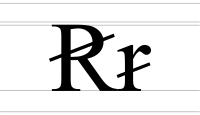
A diacritic is a glyph added to a letter or to a basic glyph. The term derives from the Ancient Greek διακριτικός, from διακρίνω. The word diacritic is a noun, though it is sometimes used in an attributive sense, whereas diacritical is only an adjective. Some diacritics, such as the acute ⟨á⟩, grave ⟨à⟩, and circumflex ⟨â⟩, are often called accents. Diacritics may appear above or below a letter or in some other position such as within the letter or between two letters.
F, or f, is the sixth letter of the Latin alphabet, used in the modern English alphabet, the alphabets of other western European languages and others worldwide. Its name in English is ef, and the plural is efs.
O, or o, is the fifteenth letter and the fourth vowel letter of the Latin alphabet, used in the modern English alphabet, the alphabets of other western European languages and others worldwide. Its name in English is o, plural oes.
R, or r, is the eighteenth letter of the Latin alphabet, used in the modern English alphabet, the alphabets of other western European languages and others worldwide. Its name in English is ar, plural ars, or in Ireland or.
S, or s, is the nineteenth letter of the Latin alphabet, used in the modern English alphabet, the alphabets of other western European languages and others worldwide. Its name in English is ess, plural esses.
U, or u, is the twenty-first letter and the fifth vowel letter of the Latin alphabet, used in the modern English alphabet, the alphabets of other western European languages and others worldwide. Its name in English is u, plural ues.
A caron is a diacritic mark commonly placed over certain letters in the orthography of some languages to indicate a change of the related letter's pronunciation.

The letter F with hook is a letter of the Latin script, based on the italic form of f; or on its regular form with a descender hook added. A very similar-looking letter, ⟨ʄ⟩, is used in the IPA for a voiced palatal implosive.

The grapheme Š, š is used in various contexts representing the sh sound like in the word show, usually denoting the voiceless postalveolar fricative /ʃ/ or similar voiceless retroflex fricative /ʂ/. In the International Phonetic Alphabet this sound is denoted with ʃ or ʂ, but the lowercase š is used in the Americanist phonetic notation, as well as in the Uralic Phonetic Alphabet. It represents the same sound as the Turkic letter Ş and the Romanian letter Ș (S-comma), the Hebrew and Yiddish letter ש, the Ge'ez (Ethiopic) letter ሠ and the Arabic letter ش.

The Polish alphabet is the script of the Polish language, the basis for the Polish system of orthography. It is based on the Latin alphabet but includes certain letters with diacritics: the acute accent ; the overdot ; the tail or ogonek ; and the stroke. ⟨q⟩, ⟨v⟩, and ⟨x⟩, which are used only in foreign words, are usually absent from the Polish alphabet. However, prior to the standardization of Polish spelling, ⟨x⟩ was sometimes used in place of ⟨ks⟩.

I is a letter used in almost all Cyrillic alphabets with the exception of Belarusian.

U is a letter of the Cyrillic script. It commonly represents the close back rounded vowel, somewhat like the pronunciation of ⟨oo⟩ in "boot" or "rule". The forms of the Cyrillic letter U are similar to the lowercase of the Latin letter Y, with the lowercase Cyrillic letter U's form being identical to that of small Latin letter Y.

The grapheme Ď is a letter in the Czech and Slovak alphabets used to denote, the voiced palatal plosive, a sound similar to British English d in dew. It was also used in Polabian. The majuscule of the letter (Ď) is formed from Latin D with the addition of a háček; the minuscule of the letter (ď) has a háček modified to an apostrophe-like stroke instead of a wedge. When collating, Ď is placed right after regular D in the alphabet.
Ŕ is a letter of the Lower Sorbian and Slovak alphabets, Ukrainian Latin alphabet and Proto-Turkic orthography. It is formed from R with the addition of an acute. Their Unicode codepoints are U+0154ŔLATIN CAPITAL LETTER R WITH ACUTE and U+0155ŕLATIN SMALL LETTER R WITH ACUTE. The PostScript names are Racute and racute.
Polish orthography is the system of writing the Polish language. The language is written using the Polish alphabet, which derives from the Latin alphabet, but includes some additional letters with diacritics. The orthography is mostly phonetic, or rather phonemic—the written letters correspond in a consistent manner to the sounds, or rather the phonemes, of spoken Polish. For detailed information about the system of phonemes, see Polish phonology.

Ꞥ is a letter derived from the combination of the Latin letter N and a stroke diacritic. Until 1921, it was used in Latvian orthography to represent the hard palatal nasal /ɲ/. It was replaced by Ņ.

Ꞩ, ꞩ, ẜ is an extended Latin letter that was used in Latvian orthography until 1921; ꞩ was also used in Lower Sorbian until 1950. A variant of the letter S with a stroke, ⟨s̸⟩, is used in Luiseño and Cupeño, and has been accepted for Unicode edition 16.

Ꞡ is a letter derived from the Latin alphabet letter G, combined with a bar diacritic. It was used in Latvian orthography before 1921.










